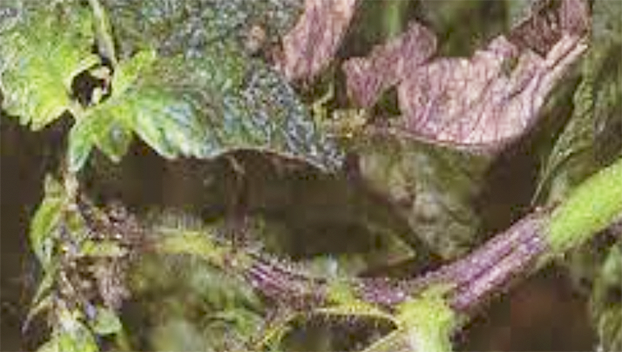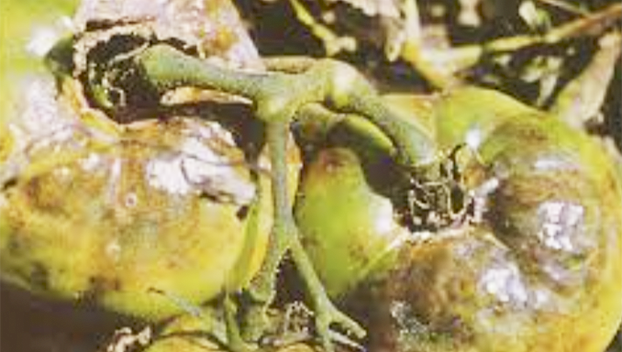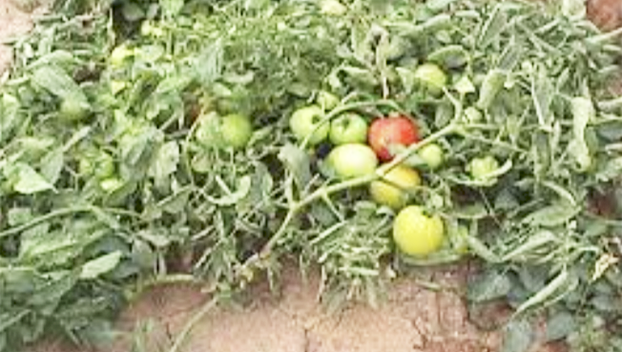Wilting tomato plant leaves: Tomato blight or wilt? Here are your answers.
Published 12:30 am Thursday, May 19, 2022

- Late Blight on tomato leaf (aggie-horticulture.tamu.edu)
|
Getting your Trinity Audio player ready...
|
First, let me begin by asking you not to use the term ‘blight’ lightly.
Many plants, not just tomatoes, are prone to disease problems. If Blight strikes your garden, you don’t just get a few discolored leaves; it’s considerably more detrimental-dark brown lesions appear on the leaves and fruits.
Blight is considered a “Typhoid Mary” type of disease, in that, spores of the deadly pathogen are broadcast through the air killing tomato, eggplant, pepper, and potato plants in surrounding gardens.
The most common types of Tomato Blight (fungi) are: Early Blight, Late Blight and Septoria.
Early Blight (Alternaria solani)– presents itself as dark, concentric circles ¼ – ½ inch on lower leaves and stems, spots on the fruit near stems and the lower leaves yellow and drop away. It affects the leaves, stem, and fruit.
Late Blight (Phytophthora infetans)– presents as blueish-gray spots on leaves, which then turn brown, before leaves are dropped. Irregular brown, greasy spots appear on the fruit with white mold rings on top of spots.
Septoria (Septoria lycopersici)– presents as small black or brown spots on the lower leaves and the lower leaves yellow and drop.
Most University Extension bulletins offer suggestions to fight the pathogen with a fungicide, but there is no known cure for blight. In this gardeners’ opinion, there is but one course of action to take for protecting your other plants and those of neighboring gardeners!
Once you’ve made the determination, quickly remove and bag the affected plants, then allow the bags to roast in our hot Texas sun for a least a week before placing the bag in the trash. If my initial option is too severe for some of you, another option is attempting to treat and control the pathogen with organic or chemical fungicides (make certain it contains copper).
Alright, enough with blight. Wilt is a pesky nuisance but easily managed condition occurring when tomatoes are grown in the same location year after year. If you continue planting in the same location subsequent years (3rd year +), the yellowing of leaves will begin sooner and progress faster and your plants will typically succumb by June.
So how does a gardener fight back against wilt? Place a sturdy metal plant tag with date to indicate where your tomatoes grow each season or record plant location in a garden log. Plant tomatoes in the same location for no more than two years, then rotate the plants to another spot for at minimum two years but three years is best.
Don’t panic if wilt strikes your plants this year, it happens! Simply remove the affected leaves straight away.
Friends, just know this will not slow the spread of the disease, but it will make you look like a better gardener to your neighbors!
There are 3 types of Tomato Wilt: Bacteria Wilt (Southern Bacterial Wilt), Verticillium Wilt, and Fusarium Wilt.
Bacterial Wilt (Pseuclomonas solanacerarum)– when it attacks, the plant wilts, dying quickly without warning.
Verticillium Wilt (Verticillium albo-atrum)– Yellow spots appear on lower leaves followed by brown veins. Leaves turn brown and fall away.
Fusarium Wilt (Fusarium oxysporum f. sp Lycopersici)– the fungus clogs the water conducting tissues preventing water and nutrients from reaching all parts of the plant. The plant usually dies.
— Written by John Green, a Texas certified master gardener in the Orange County Master Gardeners. If you have specific gardening questions or need more information, contact the Orange County Master Gardeners Helpline at 409-882-7010 or visit txmg.org/orange or Facebook: Orange County Texas Master Gardeners Association. Email extension@co.orange.tx.us.







